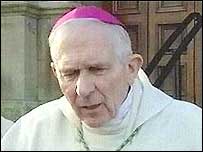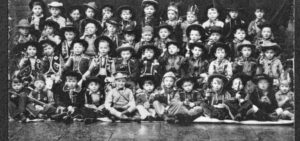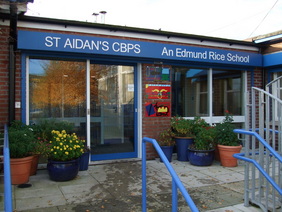THE CHRISTIAN BROTHER / EDMUND RICE SCHOOLS IN BELFAST
(This article was written by Br Charles Gallagher RIP in 1988.)
Dr. Dorrian, Bishop of Down and Connor made many requests to the Superior General of the Christian Brothers for a community of Brothers to conduct a school in Belfast. He offered the Brothers the ’National School’ in Divis Street. On November 3rd 1866, Brothers Louis Caton, Thomas Neaton, Alipius Maguire and John Ennis arrived in Belfast to form the community. They took lodgings in 26 Regent Street, behind the Memorial Church, Carlisle Circus. When Divis Street School was opened by the Brothers on the 12th November so great was the number of boys seeking admission many had to be turned away. As yet the community had no residence and so it was decided to hold a bazaar to raise the required money. Part of the proceeds was expended on building a ‘wing’ to the Diocesan College, St. Malachy’s, as a home for the Brothers.
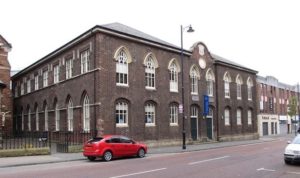 So great was the success of St. Mary’s, Divis Street a second school was deemed a necessity, so four extra Brothers arrived the next year (1867) to take charge of an establishment in Donegall Street – St. Patrick’s. The Brothers were Simeon Begley, Thomas Butler, Lawrence Burke and Jerome O’Brien. The new school opened on 27th November 1867 with four hundred and fifty pupils.
So great was the success of St. Mary’s, Divis Street a second school was deemed a necessity, so four extra Brothers arrived the next year (1867) to take charge of an establishment in Donegall Street – St. Patrick’s. The Brothers were Simeon Begley, Thomas Butler, Lawrence Burke and Jerome O’Brien. The new school opened on 27th November 1867 with four hundred and fifty pupils.
A third school was opened in Oxford St., St. Malachy’s, in 1874. The cost of the site and the building, £2,400, was a bequest from Mrs. McGill, a 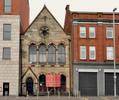 charitable lady who wished to have a school erected convenient to the Quays to serve the children of sailors and dock labourers. Mrs. McGill stated in her will that Oxford Street School should be under the care and direction of the Christian Brothers. The following year another bequest enabled the Brothers to enlarge the Divis Street school.
charitable lady who wished to have a school erected convenient to the Quays to serve the children of sailors and dock labourers. Mrs. McGill stated in her will that Oxford Street School should be under the care and direction of the Christian Brothers. The following year another bequest enabled the Brothers to enlarge the Divis Street school.
Intermediate examinations were first held in 1879 and fourteen of the Belfast boys were successful. The McGill family were so pleased they made a donation of £50. The following years showed successive lists of distinctions.
In 1900 Technical Education was introduced by the Belfast Corporation. The superior at the time, Br.T.P. Ryan, applied for a share of the funds available for Technical Education, outlining the work done in Divis Street, Donegall Street and Oxford Street. He calculated that a sum of £500 per annum would be needed to meet expenses. This was granted by the committee. As a result, a Physics Laboratory, a Chemistry Laboratory and a Lecture Room were provided at a cost of £500.
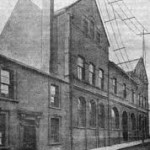 In 1903, Hardinge Street Trade School was opened. The curriculum included Science, Metalwork, Woodwork, Drawing, English, Mathematics, a Modern Language and Religion. At this time Br. Canice Craven was Superior of the community and Headmaster of Hardinge Street, with remarkable zeal and courage, attended by great success. In 1915 there was a first place in all-Ireland and a medal in Chemistry, three exhibitions valued at £20 each in Literature and Science and a third place in all-Ireland for English. In junior grade there were three exhibitions worth £15 each in Mathematics, Science and Literature, two second places in all-Ireland in Maths and Science and many other prizes. There were also two Royal College of Science scholarships (£150 each) and successes in the G.N.R. and other businesses. During Br. Young’s time of office the Bishop was D. McRory, who afterwards became Cardinal Archbishop of Armagh. He proved to be a great friend and admirer of the Brothers.
In 1903, Hardinge Street Trade School was opened. The curriculum included Science, Metalwork, Woodwork, Drawing, English, Mathematics, a Modern Language and Religion. At this time Br. Canice Craven was Superior of the community and Headmaster of Hardinge Street, with remarkable zeal and courage, attended by great success. In 1915 there was a first place in all-Ireland and a medal in Chemistry, three exhibitions valued at £20 each in Literature and Science and a third place in all-Ireland for English. In junior grade there were three exhibitions worth £15 each in Mathematics, Science and Literature, two second places in all-Ireland in Maths and Science and many other prizes. There were also two Royal College of Science scholarships (£150 each) and successes in the G.N.R. and other businesses. During Br. Young’s time of office the Bishop was D. McRory, who afterwards became Cardinal Archbishop of Armagh. He proved to be a great friend and admirer of the Brothers.
The Golden Jubilee of the Brothers’ arrival in Belfast was celebrated with High Mass in the Church of St. Mary, followed by lunch for the Bishop, Priests and Brothers. A week-long bazaar was held in St. Mary’s Hall. The expenses were £1,500, a very good investment as there was, at the end of the week, a net profit of £5,000.
The year 1921 saw the political separation of the ‘Six Counties’ from the ‘Irish Free State’. The Six County Ministry of Education asked for school particulars – number of teachers, salaries, classes, curriculum, etc. If this information was not supplied there would be no financial aid. No Catholic school answered the requisition and so were debarred from financial help.
Donegall Street School was expanded by the acquisition of a Hall for the accommodation of fourth, fifth and sixth standards.
The year 1929 saw the opening of the new St. Mary’s Secondary School in Barrack Street.
The debts incurred by all these expansions were partly met by the institution of an annual concert which realised between £350 – £450 per year.
Brother Dominic Young who had for thirty years worked in Belfast with great success was, in 1934, transferred to Dublin.
The Second World War broke out in 1939. Black-outs and air raid warnings were a constant fact of life. Nothing happened until mid-April 1941 when there was a full-scale air raid with the resultant loss of life and destruction of property, including the schools. After the raids the schools were left almost empty – eight per cent of the pupils had cleared out of the city and most of the community were scattered. Those who remained did their best to carry on with depleted and amalgamated classes. It was impossible to resume work in Hardinge Street and so it was decided to evacuate the entire school to another locality.
A second air raid, worse than the first, came three weeks later. Death and destruction were all around. The community were providently spared, although a terrific explosion shook the gable-end of the house in Fleetwood Street. Next door five of one family and three of another were blown to bits. The raid lasted for four hours, thousands of incendiaries, mines and bombs rained down on a helpless population. Schools were closed until after the summer. Hardinge Street School was accommodated in a hotel in Cushendun, Co. Antrim. Three hundred and forty boys continued their studies amid the peace and tranquillity of the Glens. The school in the Glens continued until 1943 when the Junior Technical School was back in its old quarters in Hardinge Street, as most of the population was back in residence and life was returning to normal.
When the war was over it was decided that two communities should be formed, one consisting of Brothers teaching in Hardinge Street and Donegall Street School, and the other – those of Oxford Street, Divis Street and Barrack Street. The first community took up residence in ’Somerton Lodge’, Somerton Road and the other in”Airfield House” on the Glen Road. ’Airfield House’ was the former home of the brewer, Thomas Caffrey. It had been used as a fire station by the A.R.P. during the war. It had been sold to the Bishop for £5,500, who sold it to the Brothers for the same amount. The sum required was realised by the sale of the College Wing for £3,500 and £3,640 for the houses in Fleetwood Street. In May 1947 the Superior,Brother John V. Mullins and twelve Brothers took up residence. The examination results of that year were very satisfactory, 56 Senior Certificates, 70 Junior Certificates.
Two outstanding students of that year were Henry Tipping of Armagh, who came first in the Senior Leaving Certificate in Northern Ireland and won an exhibition in literature and first place in Armagh Regional Scholarships, and Patrick Walsh who won a prize in the same grade. (Patrick Walsh went on to win two Exhibitions, Literary and Scientific, the following year.)
The 1947 Education Act brought about a great increase in the numbers in St. Mary’s and extra accommodation was urgently required. This was achieved by altering existing partitions and inserting six new ones. The extra classrooms allowed the total number of pupils to be increased to 577. By September 1950 arrangements were completed for the renting of the Foresters’ Hall to allow for the further growth in the number of pupils which was now 624.
Within a short period the school population had risen to 690 and the continuation of this upward trend was now inevitable. A new and unrestricted site was required to build a new school. Land in the neighbourhood of ‘Airfield’ became available and was acquired for £12,000 in May 1959. In that same year tenders were received for the new primary school, St. Aidan’s, in Ballymurphy. Work on St. Aidan’s began in 1959. The following year, in May 1960, work started on the new Intermediate School on the Glen Road at an estimated cost of £125,798.
During 1961 space had to be provided in Barrack Street for a couple of hundred extra pupils. This was accomplished by building three new classrooms and taking over four classrooms in St. Mary’s Primary School, Divis Street.
 A noteworthy happening in 1961 was the opening, on 4th September, of St. Aidan’s Primary School in Ballymurphy. 480 pupils were enrolled. The Brothers on the staff of St. Aidan’s formed part of a new community established in Glenfelim. They were joined by two Brothers from the Divis Street staff. Another new community was formed in ’An Dúnán’, a residence adjacent to the new intermediate school which was under construction on the Glen Road. The Intermediate School was completed and opened on 3rd September 1962 with 420 pupils.
A noteworthy happening in 1961 was the opening, on 4th September, of St. Aidan’s Primary School in Ballymurphy. 480 pupils were enrolled. The Brothers on the staff of St. Aidan’s formed part of a new community established in Glenfelim. They were joined by two Brothers from the Divis Street staff. Another new community was formed in ’An Dúnán’, a residence adjacent to the new intermediate school which was under construction on the Glen Road. The Intermediate School was completed and opened on 3rd September 1962 with 420 pupils.
In 1966 final approval was given for the building of the new St. Mary’s Grammar School on the Glen Road site. It was occupied in September 1968 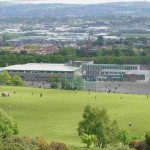 with 1,320 on rolls, 202 remaining in Barrack Street. However, the Art Rooms and Gymnasium were not ready until January 1969. The dining room and kitchen were not used until their completion in September of that year, and the swimming pool in January 1970.
with 1,320 on rolls, 202 remaining in Barrack Street. However, the Art Rooms and Gymnasium were not ready until January 1969. The dining room and kitchen were not used until their completion in September of that year, and the swimming pool in January 1970.
In August 1969 the three remaining classes in St. Malachy’s Primary School, Oxford St., were transferred to Barrack Street under Brother Titus Lynch. The final class of St. Malachy’s achieved the outstanding result of 25 pupils qualifying for grammar school out of a class of 27. By 1972 the classes of St. Malachy’s Primary School had transferred to secondary education.
Down through the years changes and developments continued to this present year. At this time (1988) the Christian Brothers are engaged in the following schools:
- St. Aidan’s Primary School, Ballymurphy:
- Christian Brothers Secondary School, Glen Road:
- Corpus Christi College, Beechmount (newly amalgamated); (Gort na Móna Secondary School being one of the amalgamated schools)
- St. Mary’s CBGS, Glen Rd. and Barrack St.;
- Edmund Rice Primary School, Pim St.;
- Our Lady of Lourdes Primary School, Park Lodge;
- Christian Brothers Secondary School, Hightown Road. (Now Edmund Rice College)
- The Brothers working in these schools live in four communities, Airfield House (Glen Road), An Dúnán (Glen Road), Cúl na Móna (Dermott Hill) and Mount Carmel (Somerton Road).
Footnote:
The above article was written By Br. Charles Gallagher in 1988. Today there are no Brothers on the staff of any of these schools. All of the existing schools are under the Trusteeship of the Edmund Rice Schools Trust (NI).
Airfield House, the former residence of Thomas Caffrey, the brewer, and then the residence of the Christian Brothers was demolished and a housing development, Airfield Heights, now exists on the site.
John Paul II Primary School, Christian Brothers School Glen Road, St Patrick’s Primary School, Edmund Rice College and St. Mary’s CBGS are now under the trusteeship of the Edmund Rice Schools Trust (NI).
St. Aidan’s Primary was amalgamated with St. Bernadette’s Primary into the new John Paul II.
Edmund Rice Primary was amalgamated with Star of the Sea Primary into the new St Patrick’s Primary.
From Hardinge Street To Hightown Road
Dr Dorrian, Bishop of Down and Connor made many requests to the Superior General of the Christian Brothers for a community of brothers to conduct a school in Belfast. On November 3rd 1866, Brothers Louis Caton, Thomas Neaton, Alipius Maguire and John Ennis, arrived in Belfast to form the community. They opened St Mary’s Divis St on the 12th November. Such was the demand for places St Patrick’s Donegal St was opened in 1867.
Hardinge Street was opened in 1903 by the Brothers with Br Craven as Headmaster. It was to function as a Trades Preparatory School for Catholic boys. The schools success was shown by its ability to place large numbers of boys in positions of work every year. It spoke volumes for the training and quality of education they received. Boys taught in the school have distinguished themselves in every walk of life and reflected honour on their teachers.
With the closure of Hardinge Street the staff and pupils transferred to the Park Lodge site on the Antrim Road in 1972 with Br Quillan as Headmaster. With limited resources and in a time of great civil unrest, the staff provided the necessary atmosphere for pupils, which led to continued exam success. Br J Murphy took over as principal with Mr Gerry McGuiness as Vice-Principal. The school moved to the new premises at Hightown Road in September 1977. Here the staff of the school have provided an atmosphere of friendliness and warmth which characterises the pupil-teacher and parent-teacher relationships. The standards of Hardinge Street have been maintained with continued exam success and large numbers of pupils gaining places of employment. (From the website of Edmund Rice College, Glengormley)
ST PATRICK’S, DONEGALL ST – IRISH NEWS ARTICLE WRITTEN BY JOHN MONAGHAN IN 2015
It’s a snapshot of more innocent times, when Christmas presents were somewhat simpler and there was not a Playstation or designer label in sight.
A photograph, sent in by an Irish News reader, shows boys from St Patrick’s Christian Brothers primary school in Belfast in early 1955 or 1956 who were asked to come to class with the outfits Santa delivered that Christmas.
While many of today’s pupils will be returning to school next week with the latest smartphones or gadgets, most of these students proudly wore the cowboy outfits which reflected the boyhood obsessions of the time.
As the oldest Catholic school in Belfast, beginning life as a national school in 1828, former pupils of St Patrick’s in Donegall Street include the boxer Rinty Monaghan, the first SDLP leader Gerry Fitt, comedian Frank Carson and renowned Irish News journalist James Kelly.
In the photograph, Seamus Ward is the third ‘cowboy’ in the second row from the bottom right, but he and his family are curious to identify as many others as possible and hear some of their stories.
St Patrick’s finally closed as a school in 1982 after more than 150 years serving north Belfast.
Its decline began after the Second World War when an expanding Catholic population saw the Christian Brothers build more schools across the city.
Some of its pupils transferred to Our Lady of Lourdes, Park Lodge on the Antrim Road, and many others then headed to the newly built Edmund Rice PS on Pim Street.
In 2013, the St Patrick’s name returned through the merger of Edmund Rice and Star of the Sea to form a new school on the Pim Street site.
After the Donegall Street building closed it served briefly as a parish community centre and survived until a fire caused severe damage in late 1995.
The damage was so bad that there was speculation that the structure would be demolished for public safety and to enable expansion of a car park.
However, in 1999 the historic building, one of the city’s last neo-Gothic properties, was restored by the Belfast Buildings Preservation Trust, which was founded in the wake of the 1995 fire.
If you are in this photograph, or you know someone who is, you can contact Rosemary Ward by email at rward99@hotmail.com.
St. Aidan’s CB PS (Closed 31st August 2013)
Aidan’s Christian Brothers Primary, Whiterock Road, Belfast
Miss Marie McIntyre was appointed Vice-Principal.
The Edmund Rice Schools Trust are the Trustees of the new school and work in
close collaboration with the Parish of Corpus Christi.

